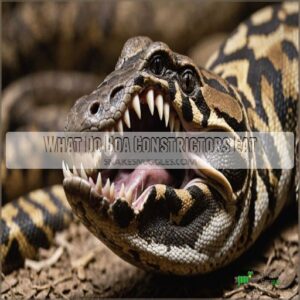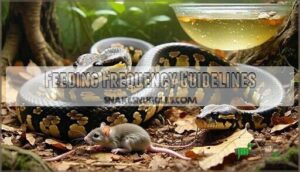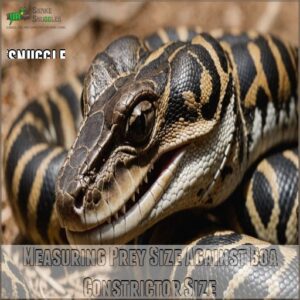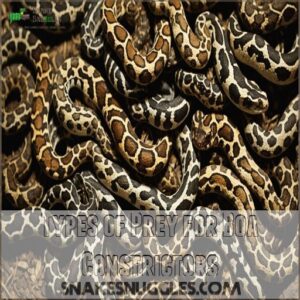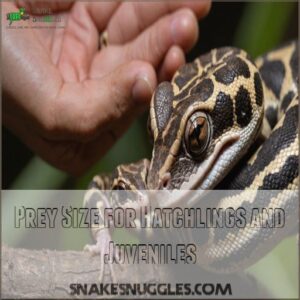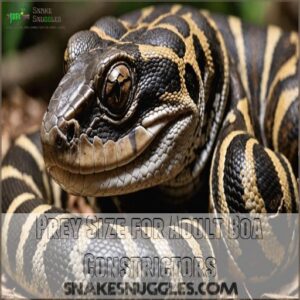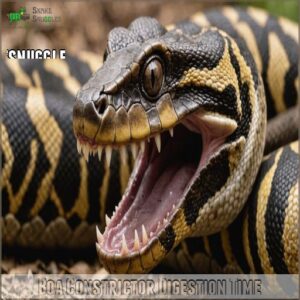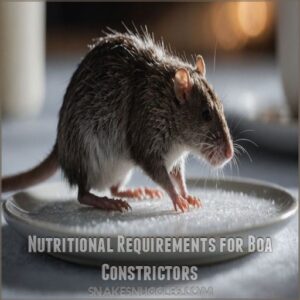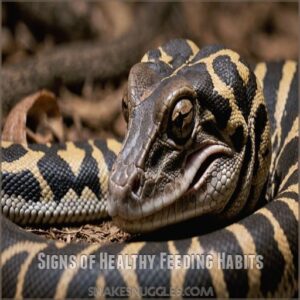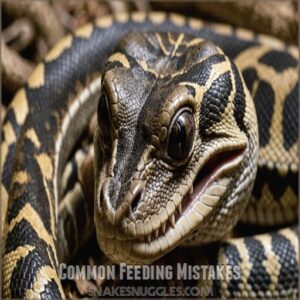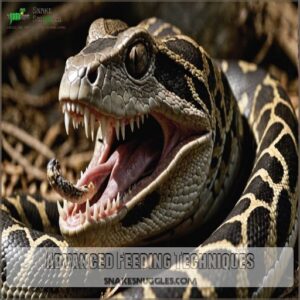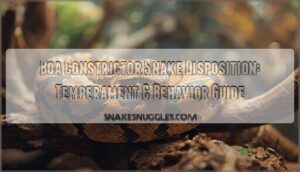This site is supported by our readers. We may earn a commission, at no cost to you, if you purchase through links.
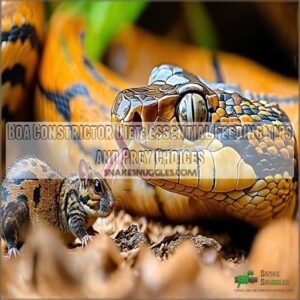
You’ll want to understand that a proper boa constrictor diet consists primarily of appropriately sized rodents, birds, or other suitable prey.
The size of the prey depends on your snake’s age and size – a small mouse for a hatchling, a larger rat for an adult.
Feeding frequency varies, but generally, you’ll feed less often as your snake gets older.
Remember, improper feeding can lead to health problems.
Overfeeding is as bad as underfeeding.
Mastering your boa constrictor’s diet gives you control over its health; it’s a key to understanding your reptile companion.
To ensure your boa constrictor is getting the nutrients it needs, maintain a 2:1 or 3:1 calcium-to-phosphorus ratio. Learn more about optimizing your snake’s nutrition and avoiding common pitfalls.
Table Of Contents
- Key Takeaways
- What Do Boa Constrictors Eat
- Feeding Frequency Guidelines
- Choosing The Right Prey Size
- Boa Constrictor Digestion Time
- Nutritional Requirements for Boa Constrictors
- Signs of Healthy Feeding Habits
- Common Feeding Mistakes
- Environmental Impact of Boa Constrictor Diet
- Advanced Feeding Techniques
- Frequently Asked Questions (FAQs)
- What do boa constrictors eat?
- Do boa constrictors eat too much?
- Can boa constrictors eat frozen thawed prey?
- Is a boa constrictor a carnivore?
- Do boa constrictors eat chickens?
- Do boa constrictors eat mice?
- What do boa constrictors eat?
- What can I feed my pet boa?
- Can boa constrictors eat dogs?
- How big can a boa constrictor eat?
- How do I transition a boa to frozen-thawed prey?
- What signs indicate my boa is still hungry?
- Can boas eat insects for added variety?
- Is it safe to feed boas wild-caught prey?
- How often should I change feed supplements?
- Conclusion
Key Takeaways
- You’ll want to provide a varied diet of frozen-thawed rodents and birds to meet your boa constrictor’s nutritional needs and prevent boredom.
- Focus on appropriate prey size; it shouldn’t be wider than your boa’s body or exceed 10% of its weight to avoid digestive issues.
- As your boa ages, adjust its feeding frequency; juveniles eat every couple of weeks, while adults need feeding about once a month.
- Use calcium and vitamin D supplements to prevent deficiencies, ensuring your boa’s bones and overall health stay robust.
What Do Boa Constrictors Eat
Boa constrictors aren’t picky eaters; they’ll happily munch on a wide range of prey, from birds to small mammals, depending on what’s available in the wild or what you provide in captivity.
Offering a varied diet is essential, as it helps your boa get all the essential nutrients for a healthy, vibrant life—though they probably won’t thank you for the gourmet menu!
Wild Diet and Prey
In the wild, boa constrictors are the masters of adaptation, feasting on a wide variety of prey. You might wonder, what do they eat? Well, it’s a juicy lineup:
- Small mammals like rodents.
- Birds, which often fall prey.
- Reptiles, when available.
- Even the occasional amphibian.
These choices reflect their strategic hunting skills and geographic adaptability.
Captive Diet and Prey
Switching from wild meals to captive care involves some thought.
Your boa’s diet can include frozen-thawed prey, which is safer than live prey and easy to find.
Make sure you provide variety to keep meals interesting and nutritionally balanced.
Remember, boredom doesn’t sit well with these serpents.
In fact, a boa constrictor’s diet needs to include whole prey items, such as frozen-thawed rodents, to provide essential nutrients like fur, feathers, and bones.
Here’s a handy table:
| Prey Type | Availability | Ethical Feeding |
|---|---|---|
| Frozen Rodents | High | Yes |
| Live Rodents | Moderate | Risky |
| Chicks | Variable | Depends |
Nutritional Requirements
You’ll need to provide your boa with a complete nutritional profile.
A balanced boa constrictor diet means focusing on calcium supplementation and vitamin supplements to prevent deficiencies.
Remember, reptile nutrition is important; regularly dusting prey with calcium supplements helps guarantee healthy bones and prevents metabolic bone disease.
A lack of these key nutrients can lead to serious health problems.
Proper calcium and vitamin D3 levels are essential for strong bones, healthy growth, and overall well-being.
Importance of Variety in Diet
While meeting boas’ nutritional requirements is key, variety in their diet does wonders for their health.
Just like us, they enjoy a menu shake-up occasionally!
Offering a mix of prey, like small mammals and birds, guarantees they’re not missing important nutrients, and even frozen Boa constrictor food can be a part of this variety.
It promotes digestive health and helps avoid deficiencies, whether your snake’s wild or captive.
Mix it up for a thriving boa!
Feeding Frequency Guidelines
Understanding the right feeding frequency for your boa constrictor is important, as it can prevent issues like obesity or malnutrition.
Remember, a young boa might need more frequent meals than its older relatives, but even snakes occasionally feel like skipping a meal—kind of like you ignoring leftovers in the fridge.
Factors Affecting Feeding Schedule
Understanding what boa constrictors eat is only part of the feeding puzzle. Knowing their diet composition, including the fact that wild boas consume varied prey, is crucial for proper nutrition and preventing vitamin deficiencies.
Factors like boa age, temperature, seasonality, and activity levels make crafting the perfect feeding schedule a cinch.
Remember, each snake’s preferences are unique!
Avoid power feeding, which might lead to stress, and give attention to their digestion time.
Keep your boa content and thriving with an adaptive feeding frequency.
Age-Based Feeding Schedule
You’ve nailed the factors; now let’s consider your boa’s life stage in its feeding schedule.
Hatchlings munch every 10-12 days, supporting their rapid growth.
Juveniles slow down a bit, needing food every two weeks.
Adults indulge just once monthly.
Remember, boas are like marathon runners, savoring their meals slowly—no need for dinner dates too often!
Seasonal Adjustments to Feeding
As your boa grows, pay attention to how seasons impact feeding.
Changes in temperature can affect their metabolism, which might lead to reduced feeding frequency during cooler months.
Consider prey availability and your snake’s natural instincts; in nature, they’d eat less when prey is scarce.
Keep these factors in mind, and your boa’s diet will stay balanced and healthy throughout the year.
Monitoring and Adjusting Feeding Schedule
To ensure optimal health, consider a boa constrictor feeding schedule that adjusts for age, with baby boas eating every 5-7 days, and check the age-based feeding schedule. Just like seasonal tweaks, monitoring your boa’s feeding schedule is key. Keep a sharp eye on:
- Boa growth rate, adjusting as needed
- Feeding frequency for the best health, considering age-specific guidelines like those outlined in a snake feeding schedule chart
- Digestion time, ensuring proper intervals
- Weight changes, balancing intake
- Prey type suitability, matching nutrition needs
With these insights, you’ll keep your snake happily thriving, less snake charmer, more snake whisperer.
Choosing The Right Prey Size
Getting the prey size right is important for your boa’s health; a meal shouldn’t exceed 10% of your snake’s weight, or be wider than its body, to avoid digestive issues and promote proper growth.
Remember, overfeeding can lead to obesity and other health problems, so careful measurement is key.
Measuring Prey Size Against Boa Constrictor Size
Imagine this: feeding your boa constrictor isn’t a game of guesswork.
You can find a variety of suitable prey options at online stores like those that sell Boa constrictor prey products here for your snake’s needs.
To ensure a healthy boa constrictor diet, understanding the snake’s natural carnivorous cravings is crucial. Follow these prey size guidelines to make sure your snake’s eating habits are in tip-top shape.
The meal shouldn’t be larger than the snake’s widest part.
Picking the right size prevents overfeeding risks, keeping your reptile care on track.
| Boa Size | Recommended Prey Size |
|---|---|
| Hatchling | Pinky mouse |
| Juvenile | Fuzzy mouse |
| Sub-adult | Adult mouse |
| Adult | Small rat |
Types of Prey for Boa Constrictors
Before choosing your boa’s next meal, consider prey availability and ethical sourcing.
Opt for small mammals and birds to guarantee proper reptile health.
It’s like ordering the right-sized pizza—stick to a prey size guide for a healthy snake.
Rodent alternatives can add variety and enrichment, keeping your boa happy and engaged while supporting effective reptile feeding.
Prey Size for Hatchlings and Juveniles
Choosing the right prey size for boa hatchlings and juveniles is key to their health.
Start small; their first feed should match their body’s girth, ensuring a smooth swallow.
Consider a prey variety to complement the hatchling growth rate, noting that newborn snakes, such as copperheads, can be as small as 7-9 inches at birth.
Here’s a simple guide:
- Choose ideal prey like pinky mice.
- Adjust feeding frequency broadly.
- Observe snake behavior for erratic feeding cues.
Prey Size for Adult Boa Constrictors
Your adult boa’s prey should align with its girth—keep the meal size at the widest part of its body.
Consistency is key, and watching your boa’s behavior helps adjust prey frequency.
As stealthy hunters, they handle constriction like pros, ensuring the right prey size is essential.
| Prey Type | Size Needed | Cost ($) |
|---|---|---|
| Rat | Medium | 5 |
| Rabbit | Large | 15 |
| Guinea Pig | Small | 8 |
| Quail | Medium | 10 |
| Gerbil | Small | 6 |
Boa Constrictor Digestion Time
Understanding a boa constrictor’s digestion time is important for setting a proper feeding schedule, avoiding issues like regurgitation.
You wouldn’t want to rush digestion—like us on Thanksgiving, boas need patience to fully process their meals.
Waiting Time Between Feedings
Once you’ve mastered prey sizing, consider timing: digestion time is key to healthy snake care.
A boa’s metabolism is slow, so don’t rush feedings; waiting prevents regurgitation risk.
Feeding frequency depends on age and size; younger boas need more frequent meals.
Remember, patience is your friend with these reptiles, letting them fully digest before each feeding.
Monitoring Digestion Process
Observe your boa’s post-feeding behavior; a swollen belly is normal.
Note the digestion time, which varies depending on the size of the meal and the snake’s age.
Watch for regurgitation signs like restlessness or repeated attempts to vomit.
Regular defecation frequency indicates healthy digestion; observe bowel movements for consistency.
Understanding these processes empowers you to provide excellent care, contributing to population monitoring and habitat preservation efforts.
Adjusting Feeding Schedule for Digestion
To avoid digestion setbacks, give your boa ample time to process its meal.
Digesting requires patience—think of it as respecting the boa’s internal clock, not over-filling a balloon that might pop.
Adjust meal frequency with seasonal changes in mind, balancing digestion time against potential risks from regurgitation.
Remember, even boas prefer a leisurely digestive fast.
Avoiding Overfeeding and Regurgitation
You’ve set the feeding schedule, but now let’s keep regurgitation at bay by avoiding overfeeding.
Pay attention to digestion time—make sure your boa’s prey frequency matches its slow metabolism.
Check its body condition regularly; a healthy boa isn’t a bloated one.
Recognizing signs of discomfort or bloating will help fine-tune your approach.
Remember: patience, like a boa’s digestion, leads to success!
Nutritional Requirements for Boa Constrictors
To keep your boa constrictor happy and healthy, you need to focus on its proper feeding frequency, such as feeding juvenile boas once a week as explained in feeding baby boa constrictors, like ensuring adequate calcium and vitamin D.
Frozen prey offers a balanced nutrition option, helping to avoid deficiencies that could make your pet snake feel more like a slithering couch potato than the agile constrictor it should be.
Importance of Calcium and Vitamin D
Strong bones and shells are essential for your boa constrictor’s vitality, and that’s where calcium and Vitamin D swoop in as heroes.
A deficiency in these vitamins can lead to weak bones and poor health.
Think of them as the dynamic duo, supporting bone health through appropriate diet choices and ensuring your snake remains a robust and majestic hunter.
Providing Supplements for Boa Constrictors
Keeping your boa constrictor healthy means meeting its nutritional needs.
Just like humans need vitamins, boas benefit from supplements like Repashy Calcium Plus and Arcadia RevitaliseD3.
These powders provide adequate calcium and vitamin D.
A pinch on prey occasionally won’t hurt and helps stave off deficiencies.
It’s like giving your scaly buddy a vitamin-packed snack!
Benefits of Frozen Prey for Nutrition
While supplements boost nutrition, frozen prey brings its own goodies to the table.
It’s safer than live prey, sparing your boa any unnecessary tango with defensive rodents.
The convenience is just the cherry on top – thaw, warm, serve.
You’ll find it’s a nutrition-rich, hassle-free way to meet your snake’s dietary needs, making both of you happy.
Avoiding Nutritional Deficiencies
Understanding your boa’s nutritional needs is key to its health.
To avoid deficiencies, make sure you offer a varied diet, including different prey animals.
Supplement choices are important; regularly dust prey with Repashy Calcium Plus or similar products to maintain proper Calcium levels and Vitamin D needs.
Remember, a balanced diet prevents problems down the road, keeping your snake happy and healthy.
Don’t neglect these important aspects of boa care!
Signs of Healthy Feeding Habits
To make sure your boa constrictor stays healthy, watch for signs like a well-proportioned body and active hunting behavior.
Keeping a feeding log can be handy, though your boa probably won’t ask for seconds like your pet dog!
Monitoring Body Condition
Curious how to keep your boa in tip-top shape? Look at its body weight and girth measurements, just like you might check your own waistline.
- Conduct regular visual assessments for muscle definition and a square shape.
- Document findings in a feeding log to spot trends.
These are your allies in ensuring healthy feeding habits without surprises.
Recognizing Overfeeding and Underfeeding
Keeping tabs on your boa’s body condition score is like managing your own fitness journey.
If your snake looks lumpy or loses its sleek shape, it’s time to rethink its menu.
Regular weight monitoring and a detailed feeding log help maintain their metabolism.
Look for visual cues of overfeeding or underfeeding; it’s all about balance!
Observing Hunting Behavior
Spotting signs of healthy feeding habits blends well with recognizing over- or underfeeding.
Observe your boa’s hunting behavior:
- Prey selection shows their preferences clearly.
- Strike speed offers insights into their agility.
- Constriction technique reveals their strength and skill.
- Post-kill behavior indicates comfort and fullness.
A keen eye for these can guarantee your boa’s thriving condition and energy.
Maintaining a Feeding Log
As you’re watching your boa’s hunting prowess, consider starting a feeding log.
This handy record is like your boa’s personal diary, helping you track feeding frequency, prey preference, and growth.
Keeping tabs on health indicators and noting any regurgitation incidents can reveal patterns.
Plus, it’s a powerful way to make sure your slithery pal’s diet is on point!
Common Feeding Mistakes
Feeding your boa constrictor might seem straightforward, but it’s easy to make a few common slip-ups that can lead to overfeeding, obesity, underfeeding, or malnutrition.
By understanding these mistakes—and perhaps picturing a boa chasing down a slightly too adventurous guinea pig—you’ll make sure your snake thrives with proper prey size, adequate calcium, and vitamin D.
Overfeeding and Obesity
You’ve mastered healthy feeding habits, but now let’s avoid the pitfalls of overfeeding.
Signs of Obesity in boas include a noticeably round body, lack of visible muscle definition, and difficulty moving.
Regularly check your boa’s Body Condition Score.
To prevent obesity, carefully manage Meal Frequency and consider Food Restriction.
Here’s how to avoid a hefty boa:
- Use a Body Condition Score chart.
- Adjust Meal Frequency based on your boa’s size and activity.
- Implement Food Restriction if needed.
- Encourage Exercise with a spacious enclosure.
Underfeeding and Malnutrition
Just as overfeeding leads to obesity, underfeeding your boa can cause malnutrition.
Signs of malnutrition? Slow growth rate and a thin body may tip you off.
It’s like expecting a plant to thrive without water.
Make sure to provide regular meals, keeping an eye on supplementation needs, to prevent metabolic bone disease and other long-term effects, securing your snake’s health.
Inadequate Calcium and Vitamin D
Your boa’s health hinges on proper nutrition.
Too little calcium and Vitamin D can lead to Metabolic Bone Disease.
Common signs of calcium and Vitamin D deficiencies include snake vitamin deficiency symptoms.
Look for symptoms like weak bones, and think about Vitamin D3 supplementation or adding dietary calcium sources to their diet.
Shell-based supplements can work wonders, giving your slithery friend the nutrients they need without the drama of a vet visit.
Improper Prey Size and Presentation
While ensuring proper vitamins, tackle the common mistake of improper prey size and presentation.
You can also find a variety of suitable food options at Boa constrictor food products.
Here’s how to avoid issues:
- Match prey size: It shouldn’t exceed the boa’s girth.
- Monitor feeding frequency: Too frequent can lead to regurgitation risks.
- Mimic hunting behavior: Use tongs to move the prey, making mealtime more engaging!
Environmental Impact of Boa Constrictor Diet
Understanding the environmental impact of a boa constrictor’s diet can help you appreciate the key role these snakes play in maintaining ecosystem balance, from controlling prey populations to affecting biodiversity.
While boas mightn’t be the most glamorous conservationists, their eating habits are essential for preserving natural habitats and ensuring species diversity.
Population Control of Prey Species
Reckon with prey species impact as your boa helps naturally manage rodent populations.
By keeping invasive species in check, your scaly friend contributes to the ecological ballet.
Imagine them as nature’s silent performers, controlling numbers with grace.
Ethical considerations emerge, ensuring your boa’s appetite aids rodent population management without unsettling balance.
That’s power right in your boa’s belly!
Ecosystem Balance and Stability
Ever ponder how boa constrictors fit into the ecosystem? They help keep nature’s dance in balance by controlling prey populations.
- Stability: Makes sure no species runs amok.
- Conservation efforts: Helps combat habitat loss and support biodiversity.
- Impact: Prevents invasive species from taking over and keeps the environment harmonious.
Their diet plays a key role!
Potential Threats to Boa Constrictor Populations
Several serious threats endanger boa constrictor populations.
Habitat loss, driven by deforestation and urbanization, shrinks their living space.
The illegal pet trade snatches them from the wild, disrupting natural populations.
Climate change alters their habitats, impacting prey availability.
Disease outbreaks can decimate local groups.
Invasive species compete for resources.
| Threat | Impact |
|---|---|
| Habitat loss | Reduced living space, less prey |
| Illegal trade | Population decline, genetic diversity loss |
| Climate change | Altered habitats, prey scarcity |
| Disease outbreaks | Mass mortality, population crashes |
| Invasive species | Competition for resources, habitat disruption |
Conservation Efforts and Management
Thinking about how habitat loss threatens boas is a sobering reality.
Yet, sustainable management through captive breeding and ethical boa trade can help.
It’s a wild world out there, and ensuring prey availability is essential for maintaining balanced ecosystems.
Encourage responsible pet ownership and conservation efforts—you might just save a snake or two, keeping the boa magic alive!
Advanced Feeding Techniques
When you’re honing your boa constrictor’s diet, advanced feeding techniques help guarantee good nutrition, prevent stress, and encourage healthy behaviors.
You might think of it like a gourmet snake buffet, featuring a variety of frozen prey, dusted with key supplements, that keeps your scaly friend thriving.
Feeding Frozen Prey for Optimal Nutrition
Frozen prey thawing helps maximize nutritional value for your boa.
Warm them gently to match the snake’s body temperature, about 98°F, so your boa finds them more appealing.
Add a touch of supplement dusting occasionally to boost vitamins and minerals, and remember to maintain a proper feeding frequency to prevent health issues.
Keep your snake’s diet consistent and nutrient-rich.
Providing Varied Prey for Balanced Diet
Spice up your boa’s life by offering a mix of prey options to provide balanced nutrition and enrichment.
Consider mice, rats, and even small birds to keep things interesting.
This variety mimics wild feeding habits and helps maintain their health.
Stick to a thoughtful feeding schedule, and remember, like humans need veggies, boas thrive on diverse prey!
Dusting Prey With Supplements
Mixing up your boa’s diet with varied prey? Smart move!
Now, think about dusting those meals with supplements.
A light sprinkle of calcium and Vitamin D3 can prevent deficiencies.
Stick to a reasonable dusting frequency and choose reputable brands like Repashy or Arcadia.
It’s like adding a multivitamin to your diet—simple but effective!
Minimizing Cage Stress During Feeding
To minimize cage stress during feeding, create a soothing feeding environment—think candle-lit dinner for boas!
Make sure your enclosure setup is secure, and the boa knows it’s feeding time.
Use soft handling techniques to guide them, and watch for stress signs, like restlessness.
Proper prey presentation is key, keeping it tantalizing yet straightforward, just like serving a favorite dish.
Frequently Asked Questions (FAQs)
What do boa constrictors eat?
Have you ever wondered what powers a boa constrictor’s strength?
Boas munch on a variety of whole animals, like birds and rodents.
Their menu isn’t just dinner; it’s a balanced powerhouse rich in nutrients.
Do boa constrictors eat too much?
Boa constrictors can overeat if fed too frequently, leading to obesity.
Balance their feeding by offering meals that are no larger than 10% of their weight and varying the schedule.
Monitor their body condition regularly.
Can boa constrictors eat frozen thawed prey?
A bag of frozen peas and a hungry boa: one brings nourishment with minimal fuss.
To prevent health issues, boa constrictors require a proper environment and handling, especially after shedding when their skin is sensitive learn about after-shed care. Yes, boa constrictors can eat frozen-thawed prey safely.
It reduces injury risks, offers nutrition, and simplifies your life—and the snake’s!
Is a boa constrictor a carnivore?
Boa constrictors are true carnivores, munching on whole animals like rodents and birds.
Their impressive constriction technique quickly subdues prey, making them efficient hunters.
It’s nature’s way of a takeaway meal!
Do boa constrictors eat chickens?
No, chickens are too large for most boas to eat. They primarily consume rodents, but their diet can be varied. Remember, responsible ownership includes appropriate-sized prey.
Do boa constrictors eat mice?
Feeding a boa constrictor mice is like serving a gourmet meal they truly enjoy.
Mice offer essential nutrients and help boas thrive.
Always opt for frozen-thawed options to guarantee safety, while minimizing the risk of injury.
What do boa constrictors eat?
Boa constrictors thrive on a carnivorous diet, mainly eating rodents like mice and rats, along with birds and lizards.
Frozen-thawed prey prevents injuries, ensuring a safe feeding experience for both you and the snake.
What can I feed my pet boa?
Bring balance to your boa’s diet by offering frozen-thawed rodents, like mice or rats, slightly warmed for safety.
Occasionally, switch up sizes and sprinkle calcium or vitamin supplements for variety, ensuring your snake’s vibrant health.
Can boa constrictors eat dogs?
You might be curious, but it’s not safe or appropriate for boas to eat dogs.
Their prey should match their size, focusing on small mammals.
Ensuring nutritional variety helps your boa thrive while keeping domestic pets safe.
How big can a boa constrictor eat?
Think of a boa constrictor like a culinary artist, selecting prey up to the size of its widest body part.
Typically, they can tackle rabbits and similar-sized animals, ensuring a meal doesn’t exceed 10% of their weight.
How do I transition a boa to frozen-thawed prey?
Start with a well-thawed rodent warmed to 98-100°F.
Use feeding tweezers for safety, offering it smoothly to mimic live prey.
Patience and consistent exposure help boas adjust, rewarding their curiosity without stress.
What signs indicate my boa is still hungry?
An insatiable appetite’s a red flag! Persistent probing, relentless searching, and an overall restless demeanor all suggest your boa’s tummy’s rumbling. Observe closely; a hungry boa won’t rest.
Can boas eat insects for added variety?
Boas can’t digest insects efficiently, so it’s best to stick to their preferred rodent diet.
While variety is important, focus on different prey types like rats and birds.
Sneaky snakes are quite the gourmet diners, after all!
Is it safe to feed boas wild-caught prey?
Feeding boas wild-caught prey isn’t safe.
Wild animals might carry parasites or diseases that could harm your boa.
Stick with the tried-and-true method of feeding them properly sourced prey for a healthy, happy snake.
How often should I change feed supplements?
Consider the idea that boas, like athletes, need diverse nutrition.
Switch up feed supplements every few weeks, ensuring a balanced diet.
This keeps them in tip-top shape, avoiding nutrient deficiencies and supporting their health.
Conclusion
Mastering the art of your boa constrictor’s diet might feel like taming a whirlwind, but it’s important for your snake’s health.
With the right combination of appropriately sized prey, you can guarantee your boa thrives.
Remember to feed less as your boa ages, and avoid overfeeding to prevent health issues.
Monitor its digestion and adjust its diet according to its needs.
By keeping an eye on these details, you support a healthy, vibrant life for your scaly friend.

